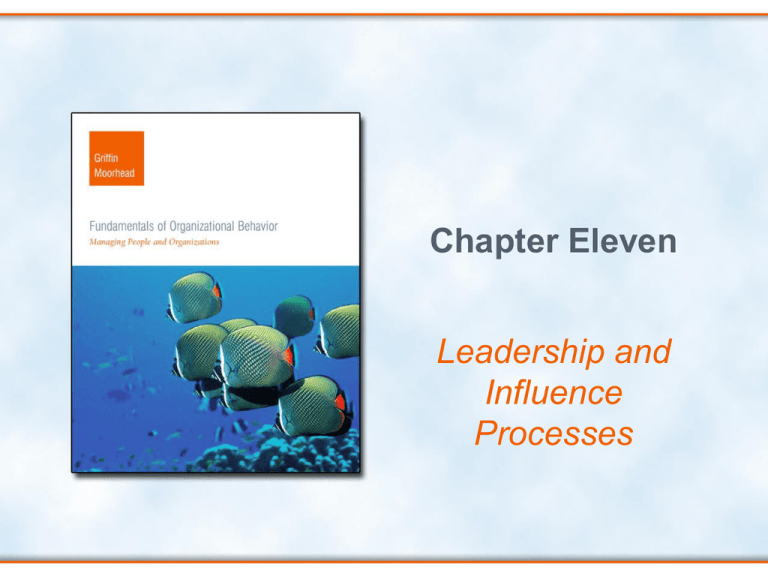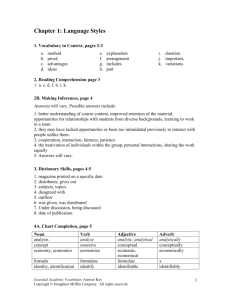
Chapter Eleven
Leadership and
Influence
Processes
Chapter Objectives
• Characterize leadership as influence.
• Discuss influence-based approaches to
leadership.
• Describe key leadership substitutes.
• Explain power in organizations.
• Discuss power and organizational
politics.
• Describe impression management.
Copyright © Houghton Mifflin Company. All rights reserved.
11-2
Leadership as Influence
• Influence is the ability to affect the
perceptions, attitudes, or behaviors of
others.
• It is the cornerstone of the leadership
process.
Copyright © Houghton Mifflin Company. All rights reserved.
11-3
Influence-Based Approaches to Leadership
• Transformational Leadership
– The set of abilities that allows the leader to
recognize the need for change, create a
vision to guide that chance, and execute
the change effectively
• Charismatic Leadership
– A type of influence based on the leader’s
personal charisma
Copyright © Houghton Mifflin Company. All rights reserved.
11-4
Figure 11.1: The Charismatic Leader
Copyright © Houghton Mifflin Company. All rights reserved.
11-5
Leadership Substitutes: Can Leadership Be
Irrelevant?
• Leadership Substitutes
– Individual, task, and organizational characteristics
that tend to outweigh the leader’s ability to affect
subordinates’ satisfaction and performance.
– Unlike traditional theories, which assume
hierarchical leadership is always important, the
premise of the leadership substitutes perspective
is that leader behaviors are irrelevant in many
situations.
Copyright © Houghton Mifflin Company. All rights reserved.
11-6
Examples of Leadership Substitutes
• Individual Characteristics
–
–
–
–
–
–
–
Ability
Experience
Training
Knowledge
Need for independence
Professional orientation
Indifference towards organizational rewards
Copyright © Houghton Mifflin Company. All rights reserved.
11-7
Examples of Leadership Substitutes
(continued)
• Task Characteristics
– A high degree of structure
– Frequent feedback
– Intrinsic satisfaction
• Organizational Characteristics
–
–
–
–
–
Explicit plans and goals
Rules and procedures
Cohesive work group
A rigid reward structure
Physical distance between supervisor and
subordinate
Copyright © Houghton Mifflin Company. All rights reserved.
11-8
Superleadership
• Superleadership
– Occurs when a leader gradually and purposefully
turns over power, responsibility, and control to a
self-managing work group
– When a team-based management approach is
implemented, a superleader can alter his or her
own personal style and become more of a coach
or facilitator than a supervisor.
Copyright © Houghton Mifflin Company. All rights reserved.
11-9
Power in Organizations
• Power is the potential ability of a person or
group to exercise control over another person
or group.
• Difference Between Power and Influence
– Power is distinguished from influence due to the
element of control.
• Considerable differences of option exist about how
thoroughly power pervades in organizations.
• Some people argue that virtually all interpersonal
relations are influenced by power; others believe
exercise of power is confined to only certain situations.
Copyright © Houghton Mifflin Company. All rights reserved.
11-10
Bases of Power
• Legitimate Power
– Granted by virtue of one’s position in the
organization
– Managers have legitimate power over their
subordinates.
• Reward Power
– The extent to which a person controls rewards that
another person values, such as:
• Pay
• Promotions
• Work assignments
Copyright © Houghton Mifflin Company. All rights reserved.
11-11
Bases of Power (continued)
• Coercive Power
– The extent to which a person has the ability to
punish or physically or psychologically harm
another
– The use of coercive power carries a considerable
cost in terms of employee resentment and hostility.
• Expert Power
– The extent to which a person controls information
that is valuable to others
• Expert power can reside in many niches in an
organization; it transcends positions and jobs.
Copyright © Houghton Mifflin Company. All rights reserved.
11-12
Bases of Power (continued)
• Referent Power
– Exists when one person wants to be like or imitates
someone else
– Similar to the concept of charisma in that it often
involves trust, similarity, acceptance, affection,
willingness to follow, and emotional involvement
• Position Power
– Resides in the position regardless of who is filling it
– Legitimate, reward, and some aspects of coercive
and expert power can all contribute to position power
• Position power is similar to authority
Copyright © Houghton Mifflin Company. All rights reserved.
11-13
Bases of Power (continued)
• Personal Power
– Resides in the person regardless of the
position he or she holds
– The primary bases of personal power are
referent and some traces of expert,
coercive, and reward power.
– Charisma may also contribute to personal
power.
Copyright © Houghton Mifflin Company. All rights reserved.
11-14
Figure 11.2: Position Power and Personal
Power
Copyright © Houghton Mifflin Company. All rights reserved.
11-15
The Uses of Power in Organizations
• Commitment
– A result of a leader’s exercise of power and the
subordinate’s acceptance and identification with
the leader
• Compliance
– A subordinate’s willingness to comply with the
leader’s wishes as long as doing so will not
require extra effort
• Resistance
– A result of the subordinate’s rejection of the leader
and refusal to cede the leader’s wishes
Copyright © Houghton Mifflin Company. All rights reserved.
11-16
Organizational Politics
• Organizational Politics is a concept closely
related to power in organizational settings in
politics or political behavior.
– Consists of activities people perform to acquire,
enhance, and use power and other resources to
obtain their preferred outcomes in a situation of
uncertainty or disagreement.
– Political behavior is the general means by which
people attempt to obtain and use power.
Copyright © Houghton Mifflin Company. All rights reserved.
11-17
The Pervasiveness of Political Behavior
• Managers see political behavior as an
undesirable but unavoidable facet of
organizational life.
• Political behavior can serve both ethical
and unethical purposes.
Copyright © Houghton Mifflin Company. All rights reserved.
11-18
Managing Political Behavior
• Reasons for Political Behavior:
– Ambiguous goals
– Scarce resources
– Technology and environment
– Non-programmed decisions
– Organizational chance
Copyright © Houghton Mifflin Company. All rights reserved.
11-19
Managing Political Behavior (continued)
• The Techniques of Political Behavior:
– Controlling as much information as
possible
– Using outside experts
– Controlling the agenda
– Game playing
– Building coalitions
– Controlling decision parameters
Copyright © Houghton Mifflin Company. All rights reserved.
11-20
Managing Political Behavior (continued)
• Limiting the Effects of Political Decisions
– The techniques for checking political activity
target:
• The reasons it occurs in the first place
• The specific techniques people use for political gains.
• Examples include:
– Open communication
– Reducing uncertainty
– Applying the adage “forewarned is forearmed”
Copyright © Houghton Mifflin Company. All rights reserved.
11-21
Impression Management
• Impression Management
– A direct and intentional effort to enhance one’s
own image in the eyes of others
• Reasons for Engaging in Impression
Management:
– To further and enhance their career prospects
– To boost their own self-esteem
– To acquire more power and control
Copyright © Houghton Mifflin Company. All rights reserved.
11-22

